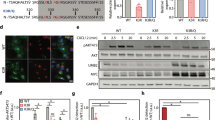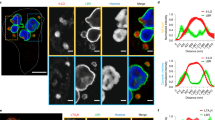Abstract
Plasma membrane cholesterol is critical for neutrophil chemotaxis, although how cholesterol affects chemotactic signaling pathway has not been clearly delineated. Here we demonstrate that cholesterol was absolutely required for polarized redistribution of key chemotactic mediators in human neutrophils in response to all chemoattractants tested (fMet-Leu-Phe, and the chemokines CXCL1, CXCL8 and CXCL12). In particular, PI3K and phosphatidylinositol-3,4,5 triphosphate (PIP3) failed to accumulate at the front and phosphatase and tensin homolog (PTEN) at the back of chemoattractant-stimulated neutrophils after cholesterol depletion. Cholesterol depletion did not affect early chemoattractant signaling events such as G-protein activation, intracellular calcium flux or G-protein-independent endocytosis-linked signaling, including the activation of mitogen-activated protein kinase (MAPK), Hck and Fgr transduced by β-arrestin. During cell polarization, F-actin assemblies redistributed the cholesterol-rich microdomains and cytoskeleton-anchored proteins, including CD16 and CD44 from the leading edge. These data suggest that spatial polarization of chemotactic mediators is orchestrated by protein:protein interactions that organize cholesterol-rich domains of the plasma membrane.










Similar content being viewed by others
Abbreviations
- APC:
-
Allophycocyanin
- DRMs:
-
Detergent-resistant membranes
- EGFR:
-
Epidermal growth factor receptor
- fMLF:
-
N-Formyl-methionine-leucine-phenylalanine
- FPR:
-
N-Formyl peptide receptor
- GPCR:
-
G-protein-coupled receptor
- GPI:
-
Glycosyl phosphatidylinositol
- GRK:
-
G-protein-coupled receptor kinase
- GROα:
-
Growth related oncogene α
- HMG-CoA:
-
Hydroxy-methyl glutaryl CoA
- IL-8:
-
Interleukin-8
- IP3 :
-
Inositol-1,4,5 trisphosphate
- Lat-B:
-
Latrunculin B
- LTB4 :
-
Leukotriene B4
- MAPK:
-
Mitogen-activated protein kinase
- MβCD:
-
Methyl-β-cyclodextrin
- PIP2 :
-
Phosphatidyl inositol 4,5 bisphosphate
- PIP3 :
-
Phosphatidylinositol-3,4,5 triphosphate
- PTEN:
-
Phosphatase and tensin homolog
- PTX:
-
Pertussis toxin
- SDF:
-
Stromal cell-derived factor
- TM:
-
Transmembrane
References
Prinz W (2002) Cholesterol trafficking in the secretory and endocytic systems. Semin Cell Dev Biol 13(3):197–203
Porter FD (2006) Cholesterol precursors and facial clefting. J Clin Invest 116(9):2322–2325
Simons K, Vaz WL (2004) Model systems, lipid rafts, and cell membranes. Annu Rev Biophys Biomol Struct 33:269–295
Pierini LM et al (2003) Membrane lipid organization is critical for human neutrophil polarization. J Biol Chem 278(12):10831–10841
Gomez-Mouton C et al (2001) Segregation of leading-edge and uropod components into specific lipid rafts during T cell polarization. Proc Natl Acad Sci USA 98(17):9642–9647
Rajendran L, Simons K (2005) Lipid rafts and membrane dynamics. J Cell Sci 118(Pt 6):1099–1102
Kim CH (2005) The greater chemotactic network for lymphocyte trafficking: chemokines and beyond. Curr Opin Hematol 12(4):298–304
Rossi D, Zlotnik A (2000) The biology of chemokines and their receptors. Annu Rev Immunol 18:217–242
Van Haastert PJ, Devreotes PN (2004) Chemotaxis: signalling the way forward. Nat Rev Mol Cell Biol 5(8):626–634
Servant G et al (1999) Dynamics of a chemoattractant receptor in living neutrophils during chemotaxis. Mol Biol Cell 10(4):1163–1178
Jin T et al (2000) Localization of the G protein betagamma complex in living cells during chemotaxis. Science 287(5455):1034–1036
Xu J et al (2003) Divergent signals and cytoskeletal assemblies regulate self-organizing polarity in neutrophils. Cell 114(2):201–214
Li Z et al (2003) Directional sensing requires G beta gamma-mediated PAK1 and PIX alpha-dependent activation of Cdc42. Cell 114(2):215–227
Gomez-Mouton C et al (2004) Dynamic redistribution of raft domains as an organizing platform for signaling during cell chemotaxis. J Cell Biol 164(5):759–768
Seveau S et al (2001) Cytoskeleton-dependent membrane domain segregation during neutrophil polarization. Mol Biol Cell 12(11):3550–3562
Nuzzi PA, Senetar MA, Huttenlocher A (2007) Asymmetric localization of calpain 2 during neutrophil chemotaxis. Mol Biol Cell 18(3):795–805
Xiao Z et al (1997) Dynamic distribution of chemoattractant receptors in living cells during chemotaxis and persistent stimulation. J Cell Biol 139(2):365–374
Nieto M et al (1997) Polarization of chemokine receptors to the leading edge during lymphocyte chemotaxis. J Exp Med 186(1):153–158
Al-Awqati Q (1999) One hundred years of membrane permeability: does Overton still rule? Nat Cell Biol 1(8):E201–E202
Lefkowitz RJ, Shenoy SK (2005) Transduction of receptor signals by beta-arrestins. Science 308(5721):512–517
Rose JJ et al (2004) On the mechanism and significance of ligand-induced internalization of human neutrophil chemokine receptors CXCR1 and CXCR2. J Biol Chem 279(23):24372–24386
Xue M et al (2004) N-formyl peptide receptors cluster in an active raft-associated state prior to phosphorylation. J Biol Chem 279(43):45175–45184
Venkatesan S et al (2003) Distinct mechanisms of agonist-induced endocytosis for human chemokine receptors CCR5 and CXCR4. Mol Biol Cell 14(8):3305–3324
Kanegasaki S et al (2003) A novel optical assay system for the quantitative measurement of chemotaxis. J Immunol Methods 282(1–2):1–11
Barlic J et al (2000) Regulation of tyrosine kinase activation and granule release through beta-arrestin by CXCRI. Nat Immunol 1(3):227–233
Varma R, Mayor S (1998) GPI-anchored proteins are organized in submicron domains at the cell surface. Nature 394(6695):798–801
Manes S et al (1999) Membrane raft microdomains mediate front-rear polarity in migrating cells. Embo J 18(22):6211–6220
Hao M, Mukherjee S, Maxfield FR (2001) Cholesterol depletion induces large scale domain segregation in living cell membranes. Proc Natl Acad Sci USA 98(23):13072–13077
Liao JK, Laufs U (2005) Pleiotropic effects of statins. Annu Rev Pharmacol Toxicol 45:89–118
Laufs U et al (2002) Impact of HMG CoA reductase inhibition on small GTPases in the heart. Cardiovasc Res 53(4):911–920
Danesh FR et al (2002) 3-Hydroxy-3-methylglutaryl CoA reductase inhibitors prevent high glucose-induced proliferation of mesangial cells via modulation of Rho GTPase/p21 signaling pathway: implications for diabetic nephropathy. PNAS 99(12):8301–8305
Kilsdonk EPC et al (1995) Cellular cholesterol efflux mediated by cyclodextrins. J Biol Chem 270(29):17250–17256
Neufeld EB et al (1996) Intracellular trafficking of cholesterol monitored with a cyclodextrin. J Biol Chem 271(35):21604–21613
Tuluc F, Meshki J, Kunapuli SP (2003) Membrane lipid microdomains differentially regulate intracellular signaling events in human neutrophils. Int Immunopharmacol 3(13–14):1775–1790
Maxfield FR, Wustner D (2002) Intracellular cholesterol transport. J Clin Invest 110(7):891–898
Iijima M, Devreotes P (2002) Tumor suppressor PTEN mediates sensing of chemoattractant gradients. Cell 109(5):599–610
Funamoto S et al (2002) Spatial and temporal regulation of 3-phosphoinositides by PI 3-kinase and PTEN mediates chemotaxis. Cell 109(5):611–623
Scheid MP, Marignani PA, Woodgett JR (2002) Multiple phosphoinositide 3-kinase-dependent steps in activation of protein kinase B. Mol Cell Biol 22(17):6247–6260
Liu E et al (2005) Targeted deletion of integrin-linked kinase reveals a role in T-cell chemotaxis and survival. Mol Cell Biol 25(24):11145–11155
Totsukawa G et al (2004) Distinct roles of MLCK and ROCK in the regulation of membrane protrusions and focal adhesion dynamics during cell migration of fibroblasts. J Cell Biol 164(3):427–439
Eddy RJ et al (2000) Ca2+-dependent myosin II activation is required for uropod retraction during neutrophil migration. J Cell Sci 113(Pt 7):1287–1298
Rajendran L et al (2003) Asymmetric localization of flotillins/reggies in preassembled platforms confers inherent polarity to hematopoietic cells. Proc Natl Acad Sci USA 100(14):8241–8246
Unkeless JC et al (1995) Function of human Fc gamma RIIA and Fc gamma RIIIB. Semin Immunol 7(1):37–44
Guo YJ et al (1994) Palmitoylation of CD44 interferes with CD3-mediated signaling in human T lymphocytes. Int Immunol 6(2):213–221
Perschl A et al (1995) Transmembrane domain of CD44 is required for its detergent insolubility in fibroblasts. J Cell Sci 108(Pt 3):1033–1041
Barlic J et al (2000) Regulation of tyrosine kinase activation and granule release through beta-arrestin by CXCRI. Nat Immunol 1(3):227–233
Barabe F et al (2002) Cholesterol-modulating agents selectively inhibit calcium influx induced by chemoattractants in human neutrophils. J Biol Chem 277(16):13473–13478
Seveau S et al (2000) Neutrophil polarity and locomotion are associated with surface redistribution of leukosialin (CD43), an antiadhesive membrane molecule. Blood 95(8):2462–2470
Millan J, Qaidi M, Alonso MA (2001) Segregation of co-stimulatory components into specific T cell surface lipid rafts. Eur J Immunol 31(2):467–473
Sanchez-Madrid F, del Pozo MA (1999) Leukocyte polarization in cell migration and immune interactions. Embo J 18(3):501–511
Devreotes P, Janetopoulos C (2003) Eukaryotic chemotaxis: distinctions between directional sensing and polarization. J Biol Chem 278(23):20445–20448
Weisswange I, Bretschneider T, Anderson KI (2005) The leading edge is a lipid diffusion barrier. J Cell Sci 118(19):4375–4380
Bodin S, Welch MD (2005) Plasma membrane organization is essential for balancing competing pseudopod- and uropod-promoting signals during neutrophil polarization and migration. Mol Biol Cell 16(12):5773–5783
Ward SG (2004) Do phosphoinositide 3-kinases direct lymphocyte navigation? Trends Immunol 25(2):67–74
Nombela-Arrieta C et al (2004) Differential requirements for DOCK2 and phosphoinositide-3-kinase gamma during T and B lymphocyte homing. Immunity 21(3):429–441
Lacalle RA et al (2004) PTEN regulates motility but not directionality during leukocyte chemotaxis. J Cell Sci 117(Pt 25):6207–6215
Li Z et al (2005) Regulation of PTEN by Rho small GTPases. Nat Cell Biol 7(4):399–404
Campbell RB, Liu F, Ross AH (2003) Allosteric activation of PTEN phosphatase by phosphatidylinositol 4,5-bisphosphate. J Biol Chem 278(36):33617–33620
Walter RJ, Marasco WA (1984) Localization of chemotactic peptide receptors on rabbit neutrophils. Exp Cell Res 154(2):613–618
Walter RJ, Marasco WA (1987) Direct visualization of formylpeptide receptor binding on rounded and polarized human neutrophils: cellular and receptor heterogeneity. J Leukoc Biol 41(5):377–391
Schmitt M, Bultmann B (1990) Fluorescent chemotactic peptides as tools to identify the f-Met-Leu-Phe receptor on human granulocytes. Biochem Soc Trans 18(2):219–222
McKay DA, Kusel JR, Wilkinson PC (1991) Studies of chemotactic factor-induced polarity in human neutrophils. Lipid mobility, receptor distribution and the time-sequence of polarization. J Cell Sci 100( Pt 3):473–479
van Buul JD et al (2003) Leukocyte-endothelium interaction promotes SDF-1-dependent polarization of CXCR4. J Biol Chem 278(32):30302–30310
Jiao X et al (2005) Ligand-induced partitioning of human CXCR1 chemokine receptors with lipid raft microenvironments facilitates G-protein-dependent signaling. Mol Cell Biol 25(13):5752–5762
Ferguson SS et al (1998) Molecular mechanisms of G protein-coupled receptor desensitization and resensitization. Life Sci 62(17–18):1561–1565
Krupnick JG, Benovic JL (1998) The role of receptor kinases and arrestins in G protein-coupled receptor regulation. Annu Rev Pharmacol Toxicol 38:289–319
Laporte SA et al (1999) The beta2-adrenergic receptor/betaarrestin complex recruits the clathrin adaptor AP-2 during endocytosis. Proc Natl Acad Sci USA 96(7):3712–3717
Mocsai A et al (1999) Adhesion-dependent degranulation of neutrophils requires the Src family kinases Fgr and Hck. J Immunol 162(2):1120–1126
Ahn S et al (2004) Differential kinetic and spatial patterns of beta-arrestin and G protein-mediated ERK activation by the angiotensin II receptor. J Biol Chem 279(34):35518–35525
Shenoy SK et al (2006) Beta-aarrestin-dependent, G protein-independent ERK1/2 activation by the beta2 adrenergic receptor. J Biol Chem 281(2):1261–1273
Gesty-Palmer D et al (2006) Distinct beta-arrestin- and G protein-dependent pathways for parathyroid hormone receptor-stimulated ERK1/2 activation. J Biol Chem 281(16):10856–10864
Sitrin RG et al (2006) Selective localization of recognition complexes for leukotriene B4 and formyl-Met-Leu-Phe within lipid raft microdomains of human polymorphonuclear neutrophils. J Immunol 177(11):8177–8184
Fong AM et al (2002) Defective lymphocyte chemotaxis in beta-arrestin2- and GRK6-deficient mice. Proc Natl Acad Sci USA 99(11):7478–7483
Sun Y et al (2002) Beta-arrestin2 is critically involved in CXCR4-mediated chemotaxis, and this is mediated by its enhancement of p38 MAPK activation. J Biol Chem 277(51):49212–49219
Ge L et al (2004) Constitutive protease-activated receptor-2-mediated migration of MDA MB-231 breast cancer cells requires both beta-arrestin-1 and -2. J Biol Chem 279(53):55419–55424
Munro S (2003) Lipid rafts: elusive or illusive? Cell 115(4):377–388
Acknowledgements
We thank Philip Murphy and Joshua Farber of LMI, NIAID for advice and comments and Owen Schwartz of the Biological Imaging Section, RTB, NIAID for technical advice. The Intramural Research Program of the National Institute of Allergy and Infectious Diseases, National Institutes of Health supported this research.
Author information
Authors and Affiliations
Corresponding author
Rights and permissions
About this article
Cite this article
Rose, J.J., Foley, J.F., Yi, L. et al. Cholesterol is obligatory for polarization and chemotaxis but not for endocytosis and associated signaling from chemoattractant receptors in human neutrophils. J Biomed Sci 15, 441–461 (2008). https://doi.org/10.1007/s11373-008-9239-x
Received:
Accepted:
Published:
Issue Date:
DOI: https://doi.org/10.1007/s11373-008-9239-x




